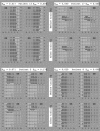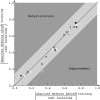Does visual restitution training change absolute homonymous visual field defects? A fundus controlled study
- PMID: 15615742
- PMCID: PMC1772456
- DOI: 10.1136/bjo.2003.040543
Does visual restitution training change absolute homonymous visual field defects? A fundus controlled study
Abstract
Aim: To examine whether visual restitution training (VRT) is able to change absolute homonymous field defect, assessed with fundus controlled microperimetry, in patients with hemianopia.
Methods: 17 patients with stable homonymous visual field defects before and after a 6 month VRT period were investigated with a specialised microperimetric method using a scanning laser ophthalmoscope (SLO). Fixation was controlled by SLO fundus monitoring. The size of the field defect was quantified by calculating the ratio of the number of absolute defects and the number of test points; the training effect E was defined as the difference between these two ratios before and after training. A shift of the entire vertical visual field border by 1 degrees would result in an E value of 0.14.
Results: The mean training effect of all right eyes was E = 0.025 (SD 0.052) and all left eyes E = 0.008 (SD 0.034). In one eye, a slight non-homonymous improvement along the horizontal meridian occurred.
Conclusions: In one patient, a slight improvement along the horizontal meridian was found in one eye. In none of the patients was an explicit homonymous change of the absolute field defect border observed after training.
Figures





Comment in
-
Vision restoration therapy.Br J Ophthalmol. 2005 May;89(5):522-4. doi: 10.1136/bjo.2005.068163. Br J Ophthalmol. 2005. PMID: 15834073 Free PMC article. No abstract available.
-
Vision restoration therapy: confounded by eye movements.Br J Ophthalmol. 2005 Jul;89(7):792-4. doi: 10.1136/bjo.2005.072967. Br J Ophthalmol. 2005. PMID: 15965150 Free PMC article. No abstract available.
-
Vision restoration therapy.Br J Ophthalmol. 2005 Sep;89(9):1229. doi: 10.1136/bjo.2005.069773. Br J Ophthalmol. 2005. PMID: 16113396 Free PMC article. No abstract available.
References
-
- Kasten E , Wüst S, Behrens-Baumann W, et al. Computer-based training for the treatment of partial blindness. Nat Med 1998;4:1083–7. - PubMed
-
- Sabel BA, Kasten E. Restoration of vision by training of residual functions. Curr Opin Ophthalmol 2000;11:430–6. - PubMed
-
- Kasten E , Wüst S, Sabel BA. Residual vision in transition zones in patients with cerebral blindness. J Clin Exp Neuropsychol 1998;20:581–98. - PubMed
-
- Kommerell G , Lieb B, Münssinger U. Rehabilitation bei homonymer Hemianopsie. Z prakt Augenheilkd 1999;20:344–52.
-
- Trauzettel-Klosinski S , Reinhard J. The vertical field border in hemianopia and its significance for fixation and reading. Invest Ophthalmol Vis Sci 1998;39:2177–86. - PubMed
MeSH terms
LinkOut - more resources
Full Text Sources
